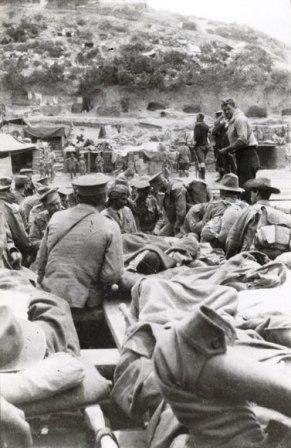Gallipoli Evacuation Begins
From the 8th to the 20th of December 1915, a total of 90,000 allied troops were evacuated from the Gallipoli Peninsula. Brigadier General Monash wrote about the upcoming evacuation, in a letter he planned to post after he left Gallipoli: It is, of course, an absolutely critical scheme which may come off quite successfully or may end in a frightful disaster. But orders, … I need not say I feel very unhappy. Being bound to secrecy, I can take none of my Staff or C.O’s into my confidence, I am almost frightened to contemplate the howl of rage and disappointment there will be when the men find out what is afoot, and how they have been fooled, and I am wondering what Australia will think at the desertion of her 6,000 dead, and her 20,000 other casualties.
The official report of the evacuation was published in the Commonwealth of Australia Gazette, No. 3, 10 January 1916. The Gazette is available on line at the National Library of Australia. To read the edition of the Commonwealth of Australia Gazette containing Charles Bean’s report click here.
 Photo: Evacuation of Gallipoli, December 1915.
Photo: Evacuation of Gallipoli, December 1915.
Source: Ferguson Collection, National Library of Australia
http://nla.gov.au/nla.pic-an24598329
Charles Bean in The Story of Anzac, Official History of Australia in the War of 1914-1918, Vol. 2, confirmed Monash’s predictions: The consideration which did go straight to every man’s heart was the tragedy of confessing failure after so many and well-loved comrades had given their lives to the effort. The men hated to leave their dead mates to the mercy of the Turks. For days after the breaking of the news there were never absent from the cemeteries men by themselves, or in twos and threes, erecting new crosses or tenderly ‘tidying-up’ the grave of a friend. This was by far the deepest regret of the troops. ‘I hope’, said one of them to Birdwood on the final day, pointing to a little cemetery, ‘I hope they don’t hear us marching down the deres (gullies)’.
One of the activities which the AIF encouraged the soldiers to take part in as the planning of the evacuation took place was the production of an ANZAC New Year Magazine. Charles Bean acted as editor for the work which was eventually published as the ANZAC Book in 1916.

Photo: Cover of the ANZAC Book [Munro collection]
The Australian War Memorial website describes the book as: composed of satirical and sombre pieces about the conditions of life at Gallipoli. It also provides a general outline of the April 25 landing at ANZAC Cove and the military advances, offensives and defensives undertaken in the following months until the eventual evacuation of the Allied forces at the end of December 1915. The introduction was written by General Sir W Birdwood, who explains how he named ANZAC Cove on the Gallipoli peninsula after the ANZAC forces. Bean contributed an editor’s note in which he outlined the harsh conditions that the book was produced in, the significance it had taken on, and acknowledged the contributors.
The Australian War Memorial collection contains examples of the original art work contributed for the book. To view this part of the AWM collection click here.

Photo: The ANZAC Book Frontispiece. Written and illustrated in Gallipoli by ‘The Men of Anzac’. [Munro Collection]
To view the ANZAC Book on line click here.
To hear about the evacuation from the New Zealander’s, the other part of the ANZAC acronym, click here.
The Anzac troops would spend three more Christmases at war before they would know ‘Peace on Earth…………..’
*****
The Families and Friends of the First AIF thanks the Australian, UK and French governments for affording Australian and British soldiers – presently buried in mass graves at Pheasant Wood – dignified individual reburials in a new CWGC cemetery at Fromelles, and applauds Minister Snowdon and his British counterpart, Parliamentary Under-Secretary of State for Defence and Minister for Veterans, Kevan Jones MP, for their joint decision to DNA test the remains at exhumation and use every reasonable method to attempt identification of each soldier.
